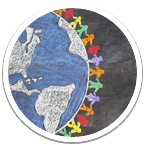Psychoeducation

Psychoeducation means sharing information about mental health and the things that affect it. Talk of psychoeducation has particularly focused on treatment of serious mental health problems. In such cases, it aims to increase understanding of the mental health condition in both the rehabilitee and those close to them and to boost their motivation for receiving treatment and managing their everyday life.
However, psychoeducation can also be used to promote health and wellbeing on a broader scale. It can be provided in a preventive or generalised manner, or alternatively aimed at a particular mental health area or symptom.
Psychoeducation reduces the inequality that results from a lack of information
Due to their different backgrounds, experiences and schooling, not all people have the same knowledge or perceptions of mental health and the factors that affect it. Lack of information and different ways of dealing with mental health can lead to inequality and affect how we talk about mental health and how we care for it and treat any problems that arise.
It is important for migrants to receive information on how mental health is usually discussed in Finland and the actions taken to support mental health and treat mental health problems. Customers may need information on, for example, the words that are used to talk about mental health and mental health problems or the ways to apply for and receive support for mental health challenges.
Psychoeducation provides reliable information about mental health
Psychoeducation can be viewed as an intervention, a method of treatment, or a working method. Guidance should be provided in a way that seeks to eliminate any unnecessary concern and fear that the customer may have about the uniqueness and severity of their problem. This is best achieved when the professional and the customer discuss the matter together and the professional is interested in hearing the customer’s own thoughts and experiences about mental health.
Effective psychoeducation includes the following elements:
- The information and guidance on mental health is relevant, as up-to-date as possible, and research-based.
- The process treats the customer in a holistic manner and seeks to reinforce their strengths and resilience (their ability to cope with difficult situations).
- The psychoeducation includes behavioural interventions that guide the customer to develop healthy habits (incl. sleep, nutrition, exercise).
- The professional ensures that the customer has opportunities to obtain additional information on the subject which is reliable and easily understandable.
- It is also a good idea to explain to the customer that the symptoms and psychological reactions are normal, to use normal, everyday language and to avoid the use of diagnostic terms (such as depression or PTSD). Being labelled as ill and hearing strange terms and explanations that they do not understand can even increase the customer’s fears about mental health and make it more difficult to seek help.
- Research has shown that group- and discussion-based and/or communal psychoeducation is more effective than simply sharing or presenting information.
Anyone can share information about good mental health
It does not always need to be a social welfare and healthcare professional who shares information about mental health. Anyone can share information about both mental health and developing and maintaining a healthy lifestyle. Indeed, it is important to talk about mental health in everyday situations and in concrete ways to reduce the fears and concerns associated with mental health issues.
References
Motlova, Lucie Bankovska ym. (2017) Psychoeducation as an Opportunity for Patients, Psychiatrists, and Psychiatric Educators: Why Do We Ignore It?. Acad Psychiatry 41, 447–451.
World Health Organization (2015) Mental Health and Psychosocial Support for Refugees, Asylum Seekers and Migrants on the Move in Europe. A multi-agency guidance note.




